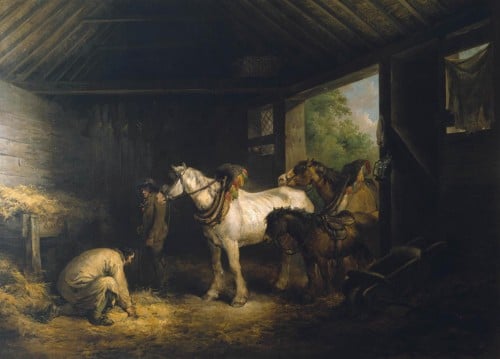George Morland: In the Margins @ The Stanley & Audrey Burton Gallery
April 9, 2015

The Stanley & Audrey Burton Gallery hosts a convincing reappraisal of George Morland’s life and work – a largely forgotten painter, who was in his lifetime (1763-1804) Britain’s most widely-celebrated. The exhibition’s thematic thread is ‘marginality’, both in terms of Morland’s art and his art-historical standing. It’s reflected in the painter’s relationship with his public, his art market, and his subject matter: from pigs to smugglers and pirates, gypsies, travellers, prostitutes, slaves and farm-hands; and latterly himself, as revealed in a rare self-portrait; we’re offered a vivid image of an artist, whose autobiographical record is otherwise clouded.
The exhibition is guest curated by Dr Nick Grindle (UCL), who gave a hospitable opening tour.
Morland’s best known paintings are of livestock – horses, pigs and dogs in particular – models for which, we’re told, cohabited in his studio. He was the first British painter to revere working animals. His 1791 masterpiece, ‘Inside of a stable’, on loan from the Tate, is a vast pastoral painting. At around 2 x 2.5 meters, it dwarfs the others on display. Its gilded frame encases an intimate and earthy chiaroscuro: two shrouded farmhands, laying the stable for an honoured guest, a glistening white horse, illuminated in ecstatic light. We were told of how a more modest stable scene, painted whilst holidaying in Yarmouth, was seized by local police. Morland was accused of treason. His accusers believed he’d concealed in the painting French invasion strategy, with its horse taken to represent the British Isles, and farm labourers, army officers considering routes of attack.

Easy Money © Huddersfield Art Gallery
Morland was no stranger to controversy. But this was rarely by virtue of his artistic preoccupations, which earned him critical praise and popularity..
Simultaneously, however, the social and art-economic networks in which he embedded himself generated suspicion from Georgian society. He was known for keeping close company with his subjects, many of whom were petty criminals. He portrayed their exploits with dispassionate realism, from smugglers looting stranded merchant ships, to prostitutes conning naïve drunks in seedy, rural taverns. Morland’s apparent reluctance to moralise his subjects in his earlier paintings, unlike his predecessor, William Hogarth, in his ‘Rake’s Progress’ series – a pictorial parable of excess and moral turpitude – gave way in his later-life to paintings surprisingly Hogarth-like; two of which, the ‘Miseries of Idleness’ and the ‘Comforts of Industry’, are on display here. Both rigidly reflect societal norms, vices and virtues, in an abstract battle between excess and prudence, yet both are starkly at odds with the artist’s earlier work and personal life.
Above all, so the story goes, Morland was excessively acquainted with tavern living. Peers and potential patrons distanced themselves from him as a result of his willingness to adopt styles, coteries and financers (predominantly art-dealers), regardless of esteem, so long as they paid for his next drink. In the Margins successfully complicates this well-trodden narrative. We see evidence of a brave painter, taking on tough subjects – criminality, empire and fringe societal life – without compromising his craft, or pandering to artistic fashions. This thoughtfully compiled exhibition offers many interesting perspectives to consider his work, and Georgian society more broadly.
Follow George on Twitter@georgekupar
George Morland: In the Margins runs until 11th July at the Stanley & Audrey Burton Gallery
Filed under: Art & Photography
Tagged with: art, artist, exhibition, free, gallery, history, leeds, museum, review



Comments